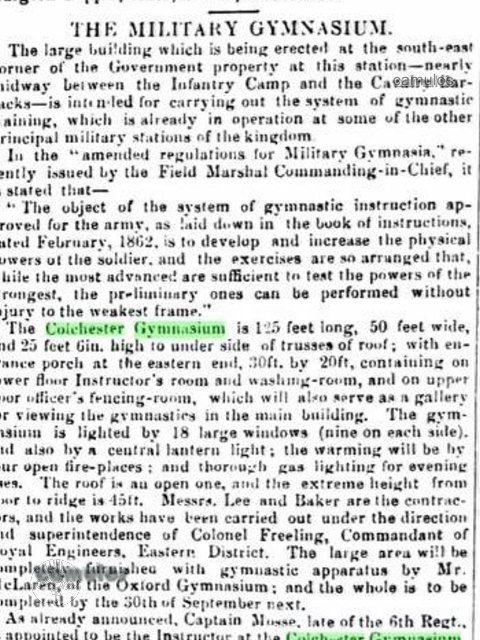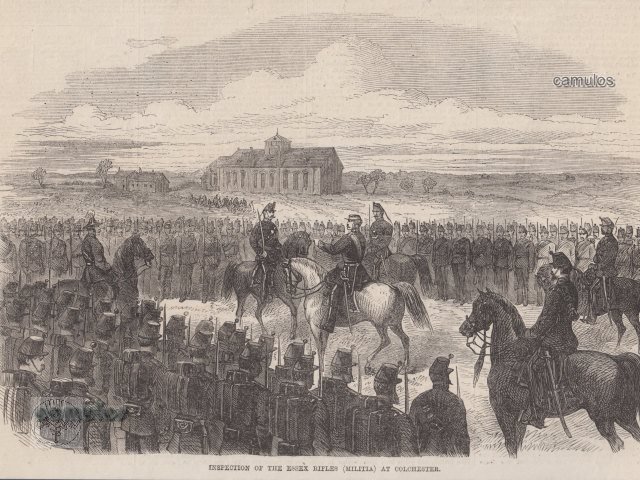

Colchester's Military Heritage Please visit the following links for more information.
Introduction What buildings still exist? 3 43 to 1750 2 1750 - 1860 4 1860 - 1900 5 1900 to present 6 A Museum? 7 Contact Us 8 Comments Received 9
Colchester Men at Trafalgar Colchester Men at Waterloo Colchester Men at Gallipoli Colchester Men at the Somme c1860 to c1900
After a decline in military activity following Waterloo, it was the Crimean War which revived building of barracks, culminating with the brick built Meeanee and Hyderabad barracks being opened in 1898. 20 acres in the parishes of East Donyland and St. Giles were added to the Middlewick range in 1874; and between 1889 and 1899 the range expanded with the aquisition of over 500 acres in the parishes of St. Giles, St. Botolph, East Donyland, and Fingringhoe. All the land lay south of the town. The purchase of St. John's Farm and the Abbey Gardens in 1860 added 156 acres to the barrack land. Between 1862 and 1864 brick-built cavalry barracks for c. 2,500 men were erected in Butt Road.
This period in our military garrison history requires further research and the results will be added here as information becomes available.
If you have anything to contribute to this, please contact us.
This engraving dates from 1856, when new hutments were constructed for the new garrison that was being created. The view looks south. To the left of the picture is what is now the New Town area, but which, in 1856 was where the new Camp Church and the Cambridge Arms pub were erected to serve the spiritual and refreshment needs of the soldier. Military Road did not exist at that time, nor the tall brick wall that was to be erected to divide civilian from military.
THE CAVALRY, ARTILLERY AND INFANTRY BARRACKS
From 1864, further land to the west was used for the construction of brick built barracks and associated buildings. Whilst the wooden hutments of The Camp were still being used, later to be replaced by the brick built Hyderabad and Meannee Barracks, these three were the first of the brick built buildings, many of which still survive today.
This map dates from the 1860s and gives detailed information about the buildings that were constructed. See the section that deals with surviving buildings for more details. The red marks show some of the buildings that have survived. In the 20th century, Circular Road North was built, which necessitated the removal of some of the barrack blocks and equipment sheds. The riding school is bottom right, now a doctor's surgery.
The following is an extract from the 1876 OS maps and shows the Flagstaff Road area that was mainly used
as Commanding Officers Headquarters, Ordnance Store Depot, Commissariat Depot, Furniture and Bedding Stores, Office, etc.
The gymnasium has a story all of its own to tell. The first record that we have is from the local newspapers dating 1865. This gave details of its construction and use and is as follows.

This is followed by a superb engraving from 1866 of an inspection of the Essex Rifles, with the newly constructed gymnasium in the background.

Further information and pictures of the gymnasium are shown here.
Soldiers, Prostitution and Brothels
Prostitution, being perhaps the oldest profession known to man, was well represented in Colchester. Soldiers in the Victorian period were prevented from getting married without the permission of their commanding officers. The presence of the garrison with so many single young men with a shilling in their pocket was a natural lure for young women of that calling to come to the town to offer their wares.
Some public house licensees, especially those whose premises were close to the barracks, saw an opportunity for increased business. They allowed the 'girls' to use their premises to ply their trade, taking a cut of their earnings in the process. These brothels soon became known to the police, whose job it became to try and close them down.
To deal with the problem, Parliament passed the first of several Contagious Diseases Acts in 1864. These were intended to regulate prostitution in six garrison towns and ports (which included Colchester), where it was assumed soldiers and sailors needed prostitutes. Any women found within a certain radius of garrison areas could be arrested and taken to be physically examined, to see whether she had a sexually transmitted infection, followed by their compulsory treatment, where necessary.
The third of the Contagious Diseases Acts of 1869 sought to limit the spread of venereal disease. Prostitutes could volunteer for examination and treatment, those doing so acquiring a sort of official licence to practise. By complying with the Act, the brothels continued in their trade, virtually protected by the law. Those who were found to be diseased, were put into the Lock Hospital (long since demolished but then located in what is now Port Lane), where they would languish for up to 9 months. The men that they had been in contact with seem to have been free to go out and infect others with impunity!
Even before the establishment of the camp in the 1850s, in 1842, the vestry of Holy Trinity parish had submitted a resolution that 'the awful extent of female prostitution in this town is a matter of deep regret to the inhabitants of the parish.' By 1867, prostitution was of sufficient concern for clergymen in the town to submit a petition against the re-licensing of inns that kept brothels, with the result that thirteen pubs in the town had their licenses suspended until investigations had been carried out into their conduct.
To avoid local leniency, police officers were recruited from the Metropolitan Police force, and normally operated in plain clothes to avoid the suspicions of the prostitutes - and the landlords that, it was suspected, were harbouring them. A newspaper report of 1869 covered the activities of one Constable Knott who seemed to be particularly effective in seeking out his quarry. It was unusual for the local press to cover such a distasteful subject, mainly out of a fear of upsetting the tender sensibilities of its female readership. However, a report of the court proceedings, which concerned prostitution at the following houses, was included in some detail:
Black Boy, Stanwell Street - said to be frequented by bad characters, but as it was in an area full of such characters, it was probably best left to cater for them rather than have them move elsewhere. Its licence was granted.Ship, Headgate - said to also be frequented by bad characters and its licence was refused.
Abbeygate, Stanwell Street - Constable Knott claimed that the house was frequented by prostitutes and bad characters. Four girls that he had found there had admitted to him that they were prostitutes. Its licence was refused.
Royal Mortar, Donyland Road - Licence refused.
Crown and Anchor, Stanwell Street - Licence refused.
Inkerman, Magdalen Street - Licensee given a warning.
Live and Let Live, Stanwell Street - Daniel Jennings, the licensee was given a warning about the conduct of his house and his licence was renewed.
Paddy's Goose, Vineyard Street - The licensee was one James Francis. Constable Knott didn't mince his words. This, he said, was a common brothel and a resort of prostitutes. The licence was refused.
Crown and Sceptre, South Street - Knott stated that this was a house where prostitutes resorted. Its licence was granted with a caution to the licensee.
It soon became of concern that these laws were unjust, as middle-class women were being arrested and prostitutes brutally examined. The campaign against the Contagious Diseases Acts, led by Josephine Butler (1826-1906), gave a powerful stimulus to an embryonic feminist movement. It must have taken great courage on her part, in an age when women were mere chattels of men and sex was a taboo subject. At the Colchester by-election in November 1870, she spoke out against Sir Henry Storks, a keen supporter of the legislation. Reports stated that local procurers (pimps) and brothel-keepers were determined to stop the repealers, by fair means or foul. On Mrs Butler's arrival in the town to help with the campaign, she tried to book into two hotels on two occasions, but, each time, the owner had to ask her to leave, when a mob gathered in the street outside and threatened to wreck the building. As the campaign went on, the violence continued. On another occasion, she and another woman were recognised in the street by a gang of hooligans after addressing a public meeting, whereby they had to run for their lives and take shelter in a cellar. The damage to Storks' reputation was done and he lost the election. Other houses are mentioned in the text of this book in connection with this trade. Landlords needed to be discreet, to avoid attracting the attention of the authorities. Because of the clandestine nature of the trade, little documentary evidence exists for the historian to call upon. It was not until the end of the first World War that the Vineyard Street area of the town, ceased to be known as 'Colchester's Red Light District,' when one presumes the last of the brothels closed down.
In 2007, an un-official view was given by a member of Her Majesty's armed forces that, 'neither brothels, nor ladies of negotiable affection, exist in Colchester, mainly due to the activities of enthusiastic amateurs'. However, that isn't to say that prostitution in the town ceased or that it no longer exists in Colchester. A glance at the personal section of our local newspapers today will confirm it!
A Timeline
1851 - The 1851 census shows Colchester had a population of 19,443. Five years later, approximately 1,700 soldiers arrived in the town.1857 - The Secretary of State for War commented in 1857 that there was 'no reason why soldiers should marry during their period of service in the army'.
1862 - An Army medical report said that the ratio per 1,000 of mean strength of service men suffering from VD in Colchester was particularly high at 464. The admissions into hospital by these diseases were…330 per 1,000 soldiers.
1864 - The Contagious Diseases Act passed in 1864, was an attempt to reduce Venereal Disease (syphilis) among soldiers and sailors - a disease for which there was as yet no diagnostic test and no safe medical remedy. This empowered police to arrest women whom they thought were prostitutes in selected ports or army towns (such as Colchester) and to compel them to undergo a medical examination.
1869 to 1886 - The Lock Hospital was operating to protect soldiers and sailors from infected women.
The following map is from the 1876 Ordnance Survey series and shows the layout of the Lock Hospital as it was then.
This is followed by two extracts from architect's plans of the building.
After the Lock Hospital experiment came to an end and it was closed, it became a general hospital for the military before being demolished in the 1950s. All that is left of it are some of the nine foot high walls, over which some of the 'girls' were known to have escaped on occasion.
Please visit the following links for more information.
Introduction What buildings still exist? 3 43 to 1750 2 1750 - 1860 4 1860 - 1900 5 1900 to present 6 A Museum? 7 Contact Us 8 Comments Received 9
Page Created
17th October 2013
revised
4th October 2015
by